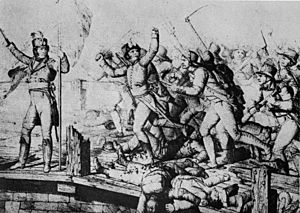Battle of Rocheserviere facts for kids
Quick facts for kids Battle of Rocheserviere |
|||||||
|---|---|---|---|---|---|---|---|
| Part of the Hundred Days | |||||||
 A scene from the Battle of Rochesevière |
|||||||
|
|||||||
| Belligerents | |||||||
| Commanders and leaders | |||||||
| Strength | |||||||
| c. 6,000 Bonapartists | c. 8,000 Vendeans | ||||||
| Casualties and losses | |||||||
| 10 killed 60 wounded |
100 killed 500 wounded |
||||||
The Battle of Rocheserviere was a fight that happened on June 20, 1815. It took place in a town called Rocheservière. This battle was between two groups: the Royalists from Vendée and Napoleon's Army of the West.
The Royalists were loyal to King Louis XVIII. Napoleon's army was led by General Jean Maximilien Lamarque. The battle ended with Napoleon's forces winning. Just five days later, a peace agreement called the Treaty of Cholet was signed. This treaty officially ended the fighting.
Contents
Why Did the Battle of Rocheserviere Happen?
After Napoleon Bonaparte returned to Paris in 1815, he started a period known as the Hundred Days. He needed to make sure all parts of France supported his new government. So, he formed the Army of the West to bring peace to certain areas.
Napoleon himself marched north to fight the British and Prussian armies. Meanwhile, General Lamarque was sent to the Vendée region. This area was a strong supporter of the King, not Napoleon. Lamarque left Nantes on June 11 with 3,000 soldiers. By June 17, his army had grown to 6,000 men. He soon learned that about 8,000 Royalist soldiers were gathering near Rocheservière. These Royalist forces were led by Charles Autichamp and Pierre Constant Suzannet.
How the Battle Unfolded
The Royalist forces in Vendée had strong defensive spots. However, their armies were split up. Suzannet's group was on the high ground of Rocheservière. They were protected by the Boulogne river, which was hard to cross. Another group, led by Bertrand Saint-Hubert, was nine kilometers east. Charles Autichamp's forces were seven kilometers northeast of Rocheservière.
These positions made it tough for Napoleon's army to attack. But on June 19, Suzannet's group suddenly moved. They left Rocheservière and went to Mormaison, southeast of their original spot. Napoleon's army saw this chance to attack.
First Clashes
Soldiers called chasseurs, led by Jean-Pierre Travot, met the Royalists at La Grolle. This area was between Rocheservière and Saint-André. But Suzannet's cavalry (soldiers on horseback) arrived. They forced Travot's men to pull back. Suzannet then brought all his troops to La Grolle.
The Main Fight
On June 20, Suzannet decided to fight Napoleon's army head-on. He asked Autichamp, the main commander, to join him. But Autichamp said he needed to secure his own position first. So, Suzannet and Saint-Hubert crossed the Boulogne river. They marched to meet Napoleon's forces.
The two armies met on the open land of Grand-Collet. This was southwest of Rocheservière. Saint-Hubert's and Suzannet's forces were quite far apart. Travot's soldiers first attacked Saint-Hubert's men. They attacked from the side, and Saint-Hubert's group quickly broke and ran away.
Suzannet arrived too late to help. Seeing his allies defeated, he bravely charged at Napoleon's lines. During this fierce fight, Suzannet was badly wounded by a bullet. General Lamarque then ordered his cavalry to attack. Suzannet's remaining forces broke apart and fled the battlefield.
The Royalists Retreat
General Autichamp, at Vieillevigne, heard about the fighting. He quickly marched towards Rocheservière. But he arrived only to see Suzannet and Saint-Hubert's forces running away. Autichamp then tried to defend the bridge over the Boulogne river.
However, Lamarque's soldiers crossed the river. They took Rocheservière and moved behind the Royalist forces. The Royalists panicked and ran away in confusion. They retreated north towards Clisson. The next day, General Suzannet died from his injuries. This happened in Aigrefeuille-sur-Maine.
What Happened After the Battle?
The Battle of Rocheserviere happened two days after Napoleon's big defeat at Waterloo. But neither side knew this at the time. The first news they got was that Napoleon had won a battle called Battle of Ligny.
This news made the Royalists try to talk peace with Lamarque. A treaty was signed five days after the battle. In this treaty, the Royalist forces agreed to stop fighting. Soon after, news arrived about Napoleon's defeat at Waterloo. Lamarque then convinced the Royalists not to keep fighting. Instead, they allowed Prussian troops to move into the area.
See also
Further read

